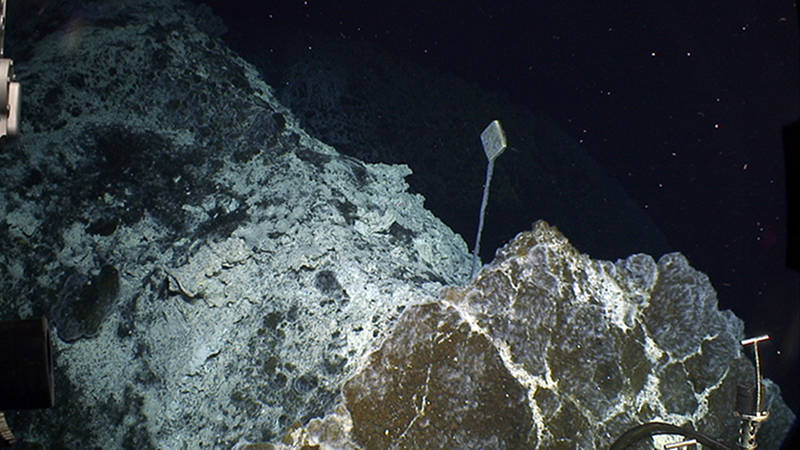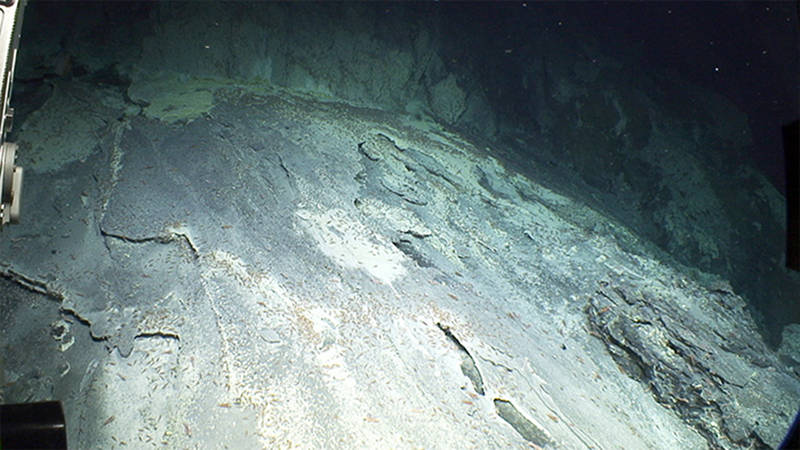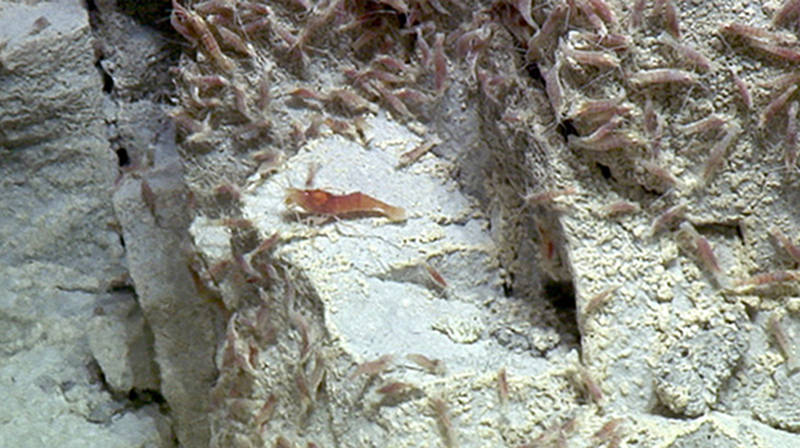
By Verena Tunnicliffe - Univerity of Victoria
December 18, 2014
Dive at NW Rota. Video courtesy of Submarine Ring of Fire 2014 - Ironman, NSF/NOAA, Jason, Copyright WHOI. Video produced by Saskia Madlener. Music by Charlie Brooks. Download (mp4, 26.6 MB)
The animal populations of NW Rota are now in expansionist mode! On this visit to the volcano, our fifth in ten years, we found no evidence of active volcanic activity but there was plenty of leaking hydrothermal fluid.

Sulfur deposits outcrop on a ridge at NW Rota near one of the markers that was left here in 2010, now covered with fuzzy microbial mat. Image courtesy of Submarine Ring of Fire 2014 - Ironman, NSF/NOAA, Jason, Copyright WHOI. Download image (jpg, 73 KB).
There were also high densities of limpets and shrimp over a much broader area than we saw four years ago. Not surprisingly, the animals do better when volcanic activity is less: partly because the habitat is more stable and partly because the hydrothermal habitat expands. Thus, there has been a large recruitment of animals to the venting areas. We saw the first evidence of this in 2010, when we documented a sulphur wall covered with juvenile shrimp – only about a centimeter long – that had recently settled from the water.

A slope covered with sulfur crusts (and tiny Opaepele shrimp) near the formerly active eruptive vents. Image courtesy of Submarine Ring of Fire 2014 - Ironman, NSF/NOAA, Jason, Copyright WHOI. Download image (jpg, 71 KB).
So, with available vent habitat and numerous vent species on neighbouring volcanoes, one might expect that many new species would arrive at the site. Not so. We find the same animals on NW Rota that have been there for years.
There are only four abundant species and a few uncommon ones; NW Rota diversity is very low.
First, the shrimp. The most common shrimp is Opaepele loihi, a small grazer that swarms around vent flows where sulphur surfaces predominate. It appears to be grazing bacterial filaments. However, it was also scattered across the old eruption sites of NW Rota.
Further away from vent fluid is a second shrimp, a species of Alvinocaris that is aggressive in its interactions and has been seen to attack the smaller species.

A large Alvinocaris shrimp is surrounded by hundreds of smaller Opaepele shrimp that are grazing on a sulfur-coated cliff face. The Alvinocaris shrimp is aggressive in its interactions and has been seen to attack the smaller species. Image courtesy of Submarine Ring of Fire 2014 - Ironman, NSF/NOAA, Jason, Copyright WHOI. Download image (jpg, 86 KB).
The biggest surprise was the great spread by the Rota limpet – a species we have seen nowhere else. This species of Shinkailepas is about two centimeters long, with a pink foot and blue shell. It lays eggcases that hatch larvae into the water. In 2010, there was a small enclave of them, but now they have spread across the volcano, leaving a trail of rocks dotted with eggcases behind them.
The easternmost vent area has nearly died out, but even there, the Neoverruca barnacles have staked claims to a much wider extent of territory. They appear to be feeding bacteria as their cirri (“tentacles”) are covered with bacterial filaments.

The Shinkailepas limpets at NW Rota were formerly only found in a small area, but have now spread over a larger area now that the volcano is inactive. Image courtesy of Submarine Ring of Fire 2014 - Ironman, NSF/NOAA, Jason, Copyright WHOI. Download image (jpg, 99 KB).
We spotted some small juvenile crabs that indicate recruitment continues to this isolated seamount. It was also interesting to see a large number of juvenile grenadiers (rattail fish), all less than 20 centimeters, hugging the seafloor even among bacterial mats. It remains an interesting question whether the larvae all remain around NW Rota or whether these populations are fed from somewhere else. Perhaps it is a bit of both.
For now, the community on NW Rota is enjoying a peaceful period without volcanic explosions in their backyard.